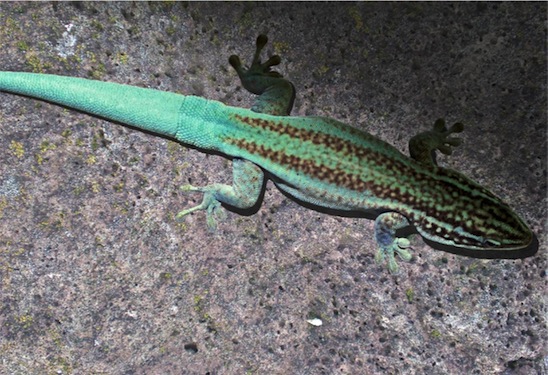
Image © Emmanuel Van Heygen
Distribution
Phelsuma barbouri is known from two localities in the higher mountain regions of Madagascar; the Ankaratra and the Andingitra Mountains where they occur above the tree line (2100-2600 m). Wether Phelsuma barbouri occurs on the mountain ridges between these two locations is uncertain. The type female (MCZ 11640) was collected by F.R. Wulsin in 1915, Loveridge (1942) indicated as Terra Typica "a forest between Tamatave and Tananarivo", which is probably not correct.
Terra Typica
Forest between Tamatave and Antananarivo, Eastern Madagascar (Probably incorrect)
Biotope
Phelsuma barbouri is the most terrestrial of all species within the genus Phelsuma. The animals are found on and around the many sun exposed rocky outcrops and boulders in this treeless habitat. The shrubs in this high altitude region are dominated by the Asteraceae (Psiadia, Helichrysum, Stoebe, Stenocline), Ericaceae (Erica, Agauria, Vaccinum), Podocarpaceae (Podocarpus), Rhamnaceae (Phylica) and Rubiaceae plant families. The rock outcrops host a drought-tolerant flora including Aloe, Kalanchoe and Helichrysum. In this high mountain climate the temperature strongly differs between day and night. At night the temperature often drops under 0° C in the austral winter. Snow has been recorded on the Andringitra Massif during winter, and the temperature can fall as low as -11°C (Saboureau 1962, Paulian et al. 1971). Further daily temperature extremes in the habitat can reach over 30°C (Langrand and Goodman 1997). Rainfall is around 2,500 mm per year on the wetter eastern slopes of these mountains, but is considerably less on the western slopes. The temperature range and intense sunlight can sometimes lead to arid conditions in the dry season. The average temperatures vary between 17° C in the austral summer and only 11° C in the winter.
Description
Phelsuma barbouri is a medium sized Gecko, which can reach up to 13 cm. The body is compact and a little flattened. The main colouration is brownish with greenish dorsal stripes. In some animals the tail is Turkish blue. The ventral part is light-grey. The upper scales around the eye are somewhat enlarged, forming a shade. Also the darker shedding, compared to other species, and the crest above the eye probably serve as form of protection from the high UV radiation in its habitat.
